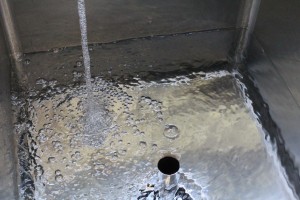If I were to ask you what areas of the United States are facing water crises, your thoughts would probably veer toward drought-prone southern California or Texas. New Orleans might come to mind, with its flooding issues and precarious below-sea-level vantage point. But we’re ok in Hampton Roads! Nothing to worry about in our water-rich neck of the woods; we’re surrounded by bridges and tunnels and rivers galore! And we’re definitely not like New Orleans with a “too much water” problem, right?
Sadly, Hampton Roads IS facing a water crisis- it’s just invisible. The Potomac aquifer, eastern Virginia’s largest water supply, is being overused and is shrinking beneath our feet. Groundwater-using industries are facing increasing regulations and new water-using industries are being told not to move to the region. The compacting aquifer is also contributing to land subsidence, which in turn is increasing the area’s susceptibility to the negative impacts of sea level rise. Hampton Roads is the second largest population at risk for the negative impacts of sea level rise, right behind infamous New Orleans. It’s not a pretty picture.

Engineers and scientists have turned “used” into “useful” at the SWIFT Pilot Facility in Seaford, Virginia.
So what do we do? How do we combat such an extensive, multi-faceted issue? Do we build flood walls? Elevate our homes on stilts? Move? There’s no one-size-fits-all solution, and there are many individuals and organizations working on the problem. HRSD is one of those organizations, and it’s tackling the situation head-on with an initiative that not only addresses the shrinking Potomac aquifer and land subsidence, but one that will help achieve Chesapeake Bay restoration goals and support our economy at the same time.
HRSD currently discharges approximately 150 million gallons of highly treated water into the waterways of Hampton Roads each day. Rather than continuing to waste this valuable resource, the Sustainable Water Initiative for Tomorrow (SWIFT) would take the water that would otherwise be discharged into the Elizabeth, James or York rivers and purify it through additional advanced water treatment to produce drinking-quality water. The purified water would then be treated to match the existing groundwater chemistry and added to the Potomac Aquifer. Hydraulic modeling suggests that this could reduce the effects of sea level rise by up to 25 percent and positively impact nearly the entire Potomac aquifer, as far north as Maryland and south beyond the North Carolina border.

With SWIFT, the York River would no longer regularly receive discharge from HRSD wastewater treatment plants.
SWIFT would also benefit the Chesapeake Bay. Replenishing groundwater with HRSD’s purified water would effectively eliminate more than 90 percent of HRSD’s discharge to local waters – reducing the total amount of nutrients such as phosphorous and nitrogen reaching the Bay. And the homes and industries in eastern Virginia that currently remove approximately 155 million gallons of groundwater from the Potomac aquifer every day would have a renewable source of groundwater to rely upon rather than an increasingly restricted one.
Extensive environmental and economic benefits aside, why is HRSD pursuing SWIFT in the first place? Its mission is to treat wastewater effectively, not to produce drinking-quality water and add it to the ground. Increasing regulations play a part. HRSD is continuously making process-level upgrades to its thirteen wastewater treatment plants to remove more and more nutrients and other contaminants from the highly treated water it discharges. By leaping forward under the assumption that the increasingly stringent regulations will continue, the next logical step would be to purify its water to the point that it’s clean enough to drink. Subsequently dumping such a valuable resource back into surface waters that don’t need it when technology exists to use it in a way that is regionally beneficial…well that just doesn’t make sense.
Secondly, HRSD is pursuing SWIFT because it recognizes that it’s part of the big picture. Land subsidence, shrinking groundwater supplies and rising seas are problems that impact ALL Hampton Roads’ residents, not just a select few. They are not problems that will go away if they’re ignored, nor are they problems with easy solutions. HRSD’s mission may be treating wastewater, but its vision is that future generations will inherit clean waterways and be able to keep them clean. SWIFT boldly meets that vision by protecting the Chesapeake Bay, securing future groundwater supplies, addressing land subsidence and helping the economy. Those are things I think we can all stand behind.
Blog contributed by Molly Bertsch, Community Educator at HRSD.
